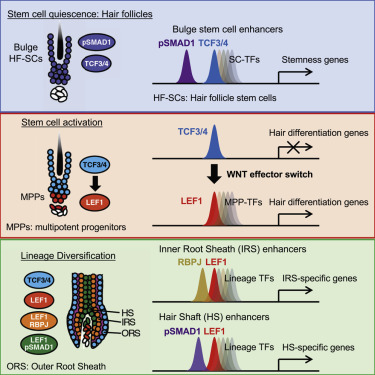当前位置:
X-MOL 学术
›
Cell Stem Cell
›
论文详情
Our official English website, www.x-mol.net, welcomes your feedback! (Note: you will need to create a separate account there.)
Temporal Layering of Signaling Effectors Drives Chromatin Remodeling during Hair Follicle Stem Cell Lineage Progression.
Cell Stem Cell ( IF 23.9 ) Pub Date : 2018-Mar-01 , DOI: 10.1016/j.stem.2017.12.004 Rene C Adam 1 , Hanseul Yang 1 , Yejing Ge 1 , Wen-Hui Lien 1 , Ping Wang 2 , Yilin Zhao 2 , Lisa Polak 1 , John Levorse 1 , Sanjeethan C Baksh 1 , Deyou Zheng 3 , Elaine Fuchs 1
Cell Stem Cell ( IF 23.9 ) Pub Date : 2018-Mar-01 , DOI: 10.1016/j.stem.2017.12.004 Rene C Adam 1 , Hanseul Yang 1 , Yejing Ge 1 , Wen-Hui Lien 1 , Ping Wang 2 , Yilin Zhao 2 , Lisa Polak 1 , John Levorse 1 , Sanjeethan C Baksh 1 , Deyou Zheng 3 , Elaine Fuchs 1
Affiliation

|
Tissue regeneration relies on resident stem cells (SCs), whose activity and lineage choices are influenced by the microenvironment. Exploiting the synchronized, cyclical bouts of tissue regeneration in hair follicles (HFs), we investigate how microenvironment dynamics shape the emergence of stem cell lineages. Employing epigenetic and ChIP-seq profiling, we uncover how signal-dependent transcription factors couple spatiotemporal cues to chromatin dynamics, thereby choreographing stem cell lineages. Using enhancer-driven reporters, mutagenesis, and genetics, we show that simultaneous BMP-inhibitory and WNT signals set the stage for lineage choices by establishing chromatin platforms permissive for diversification. Mechanistically, when binding of BMP effector pSMAD1 is relieved, enhancers driving HF-stem cell master regulators are silenced. Concomitantly, multipotent, lineage-fated enhancers silent in HF-stem cells become activated by exchanging WNT effectors TCF3/4 for LEF1. Throughout regeneration, lineage enhancers continue reliance upon LEF1 but then achieve specificity by accommodating additional incoming signaling effectors. Barriers to progenitor plasticity increase when diverse, signal-sensitive transcription factors shape LEF1-regulated enhancer dynamics.
中文翻译:

信号效应子的时间分层在毛囊干细胞沿袭进程中驱动染色质重塑。
组织再生依赖于常驻干细胞(SC),其活性和谱系选择受微环境影响。利用毛囊(HF)中组织再生的同步周期性循环,我们研究了微环境动力学如何塑造干细胞谱系的出现。利用表观遗传学和ChIP-seq分析,我们发现信号依赖性转录因子如何将时空线索与染色质动力学耦合,从而编排干细胞谱系。使用增强子驱动的报道基因,诱变和遗传学,我们显示了同时的BMP抑制和WNT信号通过建立允许多样化的染色质平台,为谱系选择奠定了基础。从机理上讲,当BMP效应物pSMAD1的结合被解除时,驱动HF干细胞主调节剂的增强子被沉默。随之而来的是,通过将WNT效应子TCF3 / 4交换为LEF1,HF干细胞中沉默的多能谱系命运增强子被激活。在整个再生过程中,谱系增强剂继续依赖LEF1,但随后通过容纳额外的传入信号传导效应子来实现特异性。当多样化的,对信号敏感的转录因子影响LEF1调控的增强子动力学时,祖细胞可塑性的壁垒就会增加。
更新日期:2018-01-11
中文翻译:

信号效应子的时间分层在毛囊干细胞沿袭进程中驱动染色质重塑。
组织再生依赖于常驻干细胞(SC),其活性和谱系选择受微环境影响。利用毛囊(HF)中组织再生的同步周期性循环,我们研究了微环境动力学如何塑造干细胞谱系的出现。利用表观遗传学和ChIP-seq分析,我们发现信号依赖性转录因子如何将时空线索与染色质动力学耦合,从而编排干细胞谱系。使用增强子驱动的报道基因,诱变和遗传学,我们显示了同时的BMP抑制和WNT信号通过建立允许多样化的染色质平台,为谱系选择奠定了基础。从机理上讲,当BMP效应物pSMAD1的结合被解除时,驱动HF干细胞主调节剂的增强子被沉默。随之而来的是,通过将WNT效应子TCF3 / 4交换为LEF1,HF干细胞中沉默的多能谱系命运增强子被激活。在整个再生过程中,谱系增强剂继续依赖LEF1,但随后通过容纳额外的传入信号传导效应子来实现特异性。当多样化的,对信号敏感的转录因子影响LEF1调控的增强子动力学时,祖细胞可塑性的壁垒就会增加。



























 京公网安备 11010802027423号
京公网安备 11010802027423号